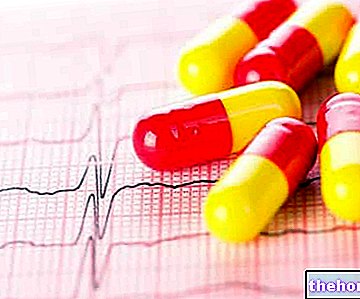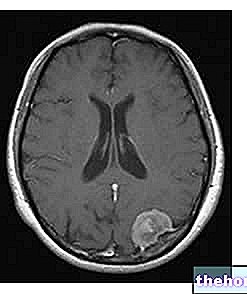Generality
Dementias are neurodegenerative diseases of the brain, which usually arise in old age (but there are exceptions) causing a progressive decline in a person's cognitive faculties.

The causes of dementia have not yet been fully clarified. At the moment, the only certainty is that it is the death of brain nerve cells and / or their malfunctioning at the level of intercellular communication that cause its onset.
The demented can exhibit a wide range of symptoms and signs; these vary according to the area of the brain affected.
Unfortunately, many forms of dementia are incurable. In fact, there is still no treatment capable of reversing or, at least, stopping the neurodegeneration process for which they are responsible.
What is dementia?
Dementia is the medical term used to indicate a group of neurodegenerative diseases of the brain, typical of old age (but not exclusive to the elderly), which involve the gradual, and almost always irreversible, reduction of a person's intellectual faculties.
CLASSIFICATION OF A DEMENTIA
Because there are so many different types of dementia, physicians with expertise in neurodegenerative diseases have long debated what could be the best way to classify them.
Today, the possible classifications are more than one and always have, as a parameter of distinction, a common general characteristic, such as:
- The area of the brain affected by neurodegeneration (N.B: for neurodegeneration s "means a process that leads to the progressive loss of neurons).
According to this parameter, dementias are divided into cortical and subcortical (or subcortical).
Cortical dementias are those that arise as a result of damage to the cerebral cortex, that is, the outermost laminar layer of the brain.
Subcortical dementias are those that appear after a deterioration of the brain portion located under the cerebral cortex.
- The reversibility or non-reversibility of dementia.
According to this parameter, dementias are divided into reversible and irreversible.
Reversible dementias are those for which there is a possibility of recovery or, at least, of regression of the symptoms. There are few with these characteristics and they are often associated with morbid conditions affecting other organs or systems.
Irreversible dementias are those that are incurable and with a tendency to a gradual and inexorable worsening (in fact, they are also called progressive). Unfortunately, they account for the majority of dementias.
- Dependence or otherwise on other morbid states.
According to this distinctive parameter, dementias are divided into primary and secondary.
Primary dementias are those that do not arise from any "other morbid state.
Secondary dementias are those that appear after other pathologies, of a neurological character (for example, amyotrophic lateral sclerosis or Parkinson's disease), traumatic (for example, after repeated blows to the head) or of another kind (vascular, infectious etc).
TYPES OF DEMENTIA
As mentioned earlier, the types of dementia are numerous. Here is a list of the most important:
- Alzheimer's disease
- Vascular dementia
- Dementia with Lewy bodies
- Frontotemporal dementia
- Boxing dementia
- HIV-associated dementia
- Huntington's disease
- Corticobasal degeneration
- Creutzfeldt-Jakob disease
- Gerstmann-Sträussler-Scheinker syndrome
Taking for example Alzheimer's disease - the most well-known form of dementia - this disease can be classified as a cortical, irreversible and primary dementia.
DEMENTIA OF CHILDREN
Dementia doesn't just affect adults.
There are, in fact, some that are exclusively borne by children (infantile dementia).
These neurodegenerative diseases are very rare and dependent on the presence of a hereditary mutation at the level of some fundamental genes.
Among the various known childhood dementias, the best known are: Niemann-Pick disease, Batten disease and Lafora (or Lafora body) disease.
NON-DEMANCES
Doctors would like to point out that, despite causing the same symptoms, the following conditions should not be considered dementia:
- Cognitive decline linked to advanced age.
As a human being ages, his brain undergoes a normal process of involution. In fact, it slowly reduces its volume, loses several neurons and no longer efficiently transmits nerve signals. - Mild cognitive impairment (or impairment).
Characterized by a less profound neurodegeneration than dementias, it often anticipates the latter. - Depression as a psychiatric disorder.
In the depressed, the disturbances are not due to a degeneration of the brain; the nerve scaffold, in fact, is intact. - The delusion.
It is a psychiatric disorder, sometimes induced by the intake of certain drugs, but nonetheless treatable.
EPIDEMIOLOGY
According to a US statistic from 2010, there are about 36 million people in the world suffering from dementia: of all these individuals, 3% are between 65 and 74 years old, 19% between 75 and 84 years old and more than half have ages 85 and up.
Most of the world's demented (50-70%) are affected by Alzheimer's disease (the most common form of dementia in humans), 25% by vascular dementia, 15% by dementia with Lewy bodies and the percentage remaining from other known forms of dementia.
In Italy, dementia sufferers are between 1 and 5% of people over 65 and 30% of people over eighty.
Given the continuous increase in average life expectancy, experts predict that in 2020 there will be around 48 million people in the world with a form of dementia.
Causes
The causes of dementia have not yet been established with certainty and clearly. Moreover, the human brain is a highly complex and difficult structure to study.
The only certain fact, relating to the triggering factors, is that any type of dementia is the result of two events: the death of brain nerve cells and / or their malfunction at the level of intercellular communication (ie between cell and cell).
DEMENTIA AND PROTEIN AGGREGATES IN THE BRAIN
Various forms of dementia - including Alzheimer's disease, dementia with Lewy bodies and frontotemporal dementia - are characterized by the presence, outside and / or inside the brain neurons, of abnormal protein aggregates (also called inclusions) .
Some of the proteins involved in these abnormal formations are the so-called beta-amyloid precursor protein (APP), the so-called tau protein and alpha-synuclein.
- APP forms amyloid plaques; these interpose themselves between neuron and neuron and are typical presences of Alzheimer's disease.
- The tau protein gives rise to neurofibrillary tangles and other similar structures; these, unlike the amyloid plaques, develop inside neurons (in the cytoplasm) and can be found in Alzheimer's patients, frontotemporal dementia and corticobasal degeneration.
- Finally, alpha-synuclein generates insoluble agglomerates within the cytoplasm called Lewy bodies; the latter are characteristic of dementia with Lewy bodies, but are also found in people with Parkinson's disease or multiple system atrophy.
Despite numerous studies conducted, researchers have not yet elucidated the precise mechanism by which protein aggregates cause the progressive deterioration of the affected brain tissue. They only know that:
- The exam post-mortem of the patients' brain tissue reveals the presence of abnormal clusters.
- In brain-healthy people, APP, tau and alpha-synuclein do not form dangerous agglomerates or in any case, if they do, they grow very slowly and a natural defense mechanism intervenes that eliminates them.




























